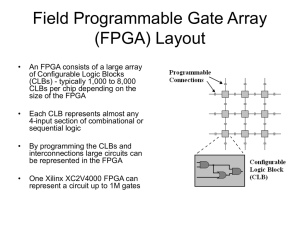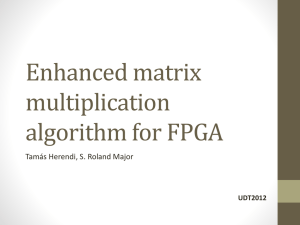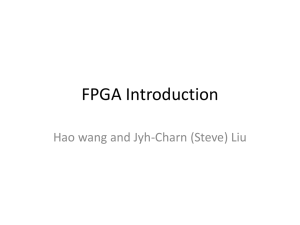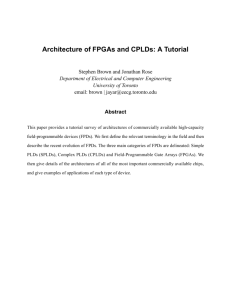Experiment Flowchart
advertisement
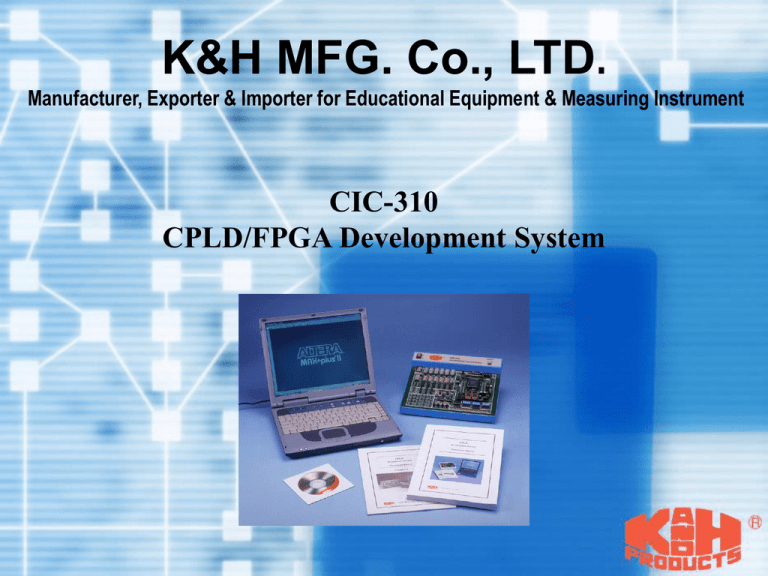
K&H MFG. Co., LTD. Manufacturer, Exporter & Importer for Educational Equipment & Measuring Instrument CIC-310 CPLD/FPGA Development System CIC-310 CPLD/FPGA Development System § CPLD / FPGA Background § Hardware Overview --- System Overview --- Development Board --- Experiment Board § Design Flowchart --- Experiment Flowchart --- Programming Flowchart --- Program manager § Experiments --- List of experiments --- Implementations CIC-310 CPLD/FPGA Development System § CPLD / FPGA Background § Hardware Overview --- System Overview --- Development Board --- Experiment Board § Design Flowchart --- Experiment Flowchart --- Programming Flowchart --- Program manager § Experiments --- List of experiments --- Implementations § CPLD/FPGA BACKGROUND – (1) Traditional design flow of the logic circuit Design specification In = A, B, C, D ... Out = X, Y … Manual Truth table Manual (K-map) Boolean expression Manual Implement on several ICs X = (Ā+B+C) (B+D) ( Ā+D ) PAL – Programmable Array Logic Programmable AND array followed by fixed fan-in OR gates A B C Programmable switch or fuse f1 A B C A B C AND plane PLD - Programmable Logic Device A B C D Q Q PLD HDL : Hardware Description Language A B C D S0 S1 AND plane Q CPLD (Complex PLD) Structure Integration of several PLD blocks with a programmable interconnect on a single chip PLD Block • • • • • • I/O Block PLD Block I/O Block I/O Block • • • Interconnection Matrix I/O Block • • • PLD Block PLD Block FPGA Look-Up Tables (LUT) • Look-up table with N-inputs can be used to implement any combinatorial function of N inputs • LUT is programmed with the truth-table A B C D Z 0 0 0 0 0 0 0 0 1 1 1 1 1 1 1 0 0 0 0 1 1 1 1 0 0 0 0 1 1 1 0 0 1 1 0 0 1 1 0 0 1 1 0 0 1 0 1 0 1 0 1 0 1 0 1 0 1 0 1 0 0 1 1 1 0 1 1 1 0 1 1 1 0 0 0 Truth-table A B C D LUT Z LUT implementation A B Z C D Gate implementation • FPGAs vs. CPLDs • Are FPGAs and CPLDs the same thing? No. Both are programmable digital logic chips. Both are made by the same companies. But they have different characteristics. • FPGAs are "fine-grain" devices. That means that they contain a lot (up to 100000) of tiny blocks of logic with flip-flops. CPLDs are "coarse-grain" devices. They contain relatively few (a few 100's max) large blocks of logic with flip-flops. • FPGAs are RAM based. They need to be "downloaded" (configured) at each power-up. CPLDs are EEPROM based. They are active at power-up (i.e. as long as they've been programmed at least once...). • CPLDs have a faster input-to-output timings than FPGAs (because of their coarse-grain architecture, one block of logic can hold a big equation), so are better suited for microprocessor decoding logic for example than FPGAs. • FPGAs have special routing resources to implement efficiently binary counters and arithmetic functions (adders, comparators...). CPLDs do not. • FPGAs can contain very large digital designs, while CPLDs can contain small designs only. FPGA & CPLD • FPGAs are RAM based. They need to be "downloaded" (configured) at each power-up. CPLDs are EEPROM based. They are active at power-up (i.e. as long as they've been programmed at least once...). • FPGAs can contain very large digital designs, while CPLDs can contain small designs only. • CPLDs have a faster input-to-output timings § CPLD/FPGA BACKGROUND – (2) Modern design flow of the logic circuit Design specification In = A, B, C, D ... Out = X, Y … Manual (programming) Design description Automatic Implement on ONE CPLD/FPGA chip Save lots of time!!! HDL Syntax SOPC (System On Programmable Chip) MCU MPU Decoder PWM FPGA/CPLD Converter Memory ALU Counter GPIO Control Timer CIC-310 CPLD/FPGA Development System § CPLD / FPGA Background § Hardware Overview --- System Overview --- Development Board --- Experiment Board § Design Flowchart --- Experiment Flowchart --- Programming Flowchart --- Program manager § Experiments --- List of experiments --- Implementations § System Overview CIC-310 = CPLD/FPGA Development Board + Experiment Board CIC-310 provides digital system designers with an economical solution for hardware verification or students with an efficient learning of digital system design. § Hardware Overview – Development Board 89C2051 for load the configuration data to FPGA or SEEPROM devices with data compression techniques Reset button: Reset connection to PC Program selector jumper Altera 8k/10k RAM-based FPGA Max. 32kB SEEPROM HIN230 for RS-232 transmitters/receivers interface circuits 11.0592MHz Xosc RS232 connector 7.5C DC Power § Hardware Overview – Experiment Board 16-Segment Display Section 6-Digit Parallel-Serial 7-segment Display Output Logic LED Display 20MHz X’TRAL OSC 5 x 7 DOT LED display RC Oscillator Logic Switch Input Section SW and Keypad Section Pulse generator Input Status Logic LED Display CIC-310 CPLD/FPGA Development System § CPLD / FPGA Background § Hardware Overview --- System Overview --- Development Board --- Experiment Board § Design Flowchart --- Experiment Flowchart --- Programming Flowchart --- Program manager § Experiments --- List of experiments --- Implementations § EXPERIMENT FLOWCHART Windows 98/2000/XP Programming Rs-232 Download the program Personal Computer Development Board Program manager Show the result Experiment Board § Programming Flowchart § Program manager functions Add the program to SEEPROM Execute the program from SEEPROM Download the program to FPGA and execute the program CIC-310 CPLD/FPGA Development System § CPLD / FPGA Background § Hardware Overview --- System Overview --- Development Board --- Experiment Board § Design Flowchart --- Experiment Flowchart --- Programming Flowchart --- Program manager § Experiments --- List of experiments --- Implementations § LIST OF EXPERIMENTS • Combinational logic circuits – – – – Applications of ALUs Encoder / Decoder Alpha-Nemaric LED display Multiplexer / Demultiplexer • Sequential logic circuits – Flip-flop circuits – Applications of counters – Frequency synthesizers / Shift Registers • Dynamic 5x7 LED matrix display • 4x4 keypad of matrixes More than 50 examples in the experimental manual!!! Implementations Exp1 : Step by step design of basic logic circuit by Graphic and Text Editor Exp2 : Binary-to-16-segment decoder Exp3: Counters Exp4: 5X7 DOT matrix display Exp5: Keypad Exp1: Basic logic circuit design (Primal.gdf) Specification: Output : P55, P56, P57, P58 Input: DIP switches Output: LED display Relation: P55 = !P01 P56 = P02 & P03 P57 = P04 # P06 P58 = P07 $ P08 ! => NOT & => AND # => OR $ => XOR Input: P01, P02, P03, P04, P06, P07, P08 Step 1: Programming by graphic editor P01 P55 P02 P03 P56 P04 P06 P57 P07 P08 P58 Step 2: Assign Devices (Assign / Devices) Step 3: Save&Compile (Max+Plus II / Compiler) Step 4: Simulation ( 1. Max+Plus II / Waveform Editor ) ( 2. Max+Plus II / Simulator) Step 4: Pin Assignment ( Max+Plus II / Floorplan Editor) Step 5: Download the program Execute the program from SEEPROM Add the program to SEEPROM Download the program to FPGA and execute the program Program by Text Editor --- Primal.tdf The rest design steps are the same Exp2: Binary-to-16-segment decoder Specification: Output : 16-segment display Input: DIP switches Output: 16-segment display Relation: 6 bit inputs are decoded to 16-segment display as: Numerical number : 0~9 Alphabet letters : A~Z Math Operators: *, +,-,/ Why you need 6-bit input? 0~9 10 A~Z 26 *,+,-,/ 4 10+26+4=40 2^6 = 64 > 40 Input: P01, P02, P03, P04, P06, P07 Program by Text Editor --- 16segb.tdf . . . Symbol a1 a2 b1 b2 c1 c2 d1 d2 e1 e2 g1 g2 h1 h2 i1 i2 /p Position 1 2 3 4 5 6 7 8 9 10 11 12 13 14 15 16 17 Pin Assignment (1) 2 1 16segment FPGA 8K 10k 16segment FPGA 8K 10k A1 P13 P16 E2 P23 P27 A2 P14 P17 G1 P24 P28 B1 P15 P18 G2 P25 P29 B2 P16 P19 H1 P27 P30 C1 P18 P21 H2 P28 P35 C2 P19 P22 I1 P29 P36 D1 P20 P23 I2 P30 P37 D2 P21 P24 DP P63 P64 E1 P22 P25 C-SEL P23 P27 Table 1-6 16 segment display pin-out (8k-84pin) Pin Assignment (2) P13 P14 P27 P24 P29 P15 P21 P22 P20 P30 P25 P28 P19 Symbol Segment Pin P23 P16 P63 P18 a1 a2 b1 b2 c1 c2 d1 d2 e1 e2 g1 g2 h1 h2 i1 i2 /p 0 1 2 3 4 5 6 7 8 9 10 11 12 13 14 15 16 13 14 15 16 18 19 20 21 22 23 24 25 27 28 29 30 63 Show Result FPGA JP8 JP8 FPGA Pin Symbol JP9 JP9 JP10 JP10 16 17 18 19 21 22 23 24 25 27 28 28 30 35 36 37 64 a1 a2 b1 b2 c1 c2 d1 d2 e1 e2 g1 g2 h1 h2 i1 i2 /p Exp3: Counters Specification: Output : P55, P56, P57, P58 Construct a 4-bit asynchronous counter by T flip-flops Input: Enable: Sw1_1 Reset: Sw1_2 Clock: SWP3 Output: LED display Relation: The 4-bit ripple counter repeats itself for every 2^4 (16) clock pulses. : Input: Sw1_1, p01 (Enable) Sw1_2, P02 (Reset) SWP3, P83 (Clock) Asynchronous Counter: Program by Graphic Editor --- 4slcnt.gdf Asynchronous Counter: Program by Text Editor --- 4slcnt.gdf TFF primitive Asynchronous Counter: Program by Text Editor --- 4slcnt.gdf FF[]=FF[]-1; Synchronous Counter: Program by Graphic Editor --- ptcnt8.gdf Synchronous Counter: Program by Text Editor --- ptcnt8t.tdf Delay Matrix Asynchronous Counter Synchronous Counter 4 Digit Counter: Frequency Counter --- pdec9999.tdf Input: Clock Output: LED Display (Counting 0~9999 in binary format) 7 segment displayer --- 7segd.tdf Input: DIP switch Output: 7 segment displayer SA SB SC SD SE SF SG 4 Digit Counter: Parallel mode --- 4dec7sp.tdf Require Pins: 6 x 4 = 24 01 2 34 5 6 7 89 01 2 34 5 6 7 89 01 2 34 5 6 7 89 4 Digit Counter: Serial Scan mode --- 4dec7sn.tdf Require Pins: 6 x 1 + 4 = 10 0 1 0 2 0 3 0 4 0 5 Exp4: 5x7 dot matrix display 5x7 Matrix DOT display (dot_test.tdf) P13 PA1 P14 PA2 P15 PA3 P16 PA4 P18 PA5 P19 PA6 P20 PA7 P22P23P24P25P27 1 0 1 0 1 0 1 5x7 DOT Matrix display (dot_test.tdf) Counter P13 PA1 P14 PA2 P15 PA3 P16 PA4 P18 PA5 P19 PA6 P20 PA7 P22 P23 P24 P25 P27 TRY 57dots.hex !!! Exp5: Keypad P48 P43 P39 P34 Individual Mode --- require 16 ports P49 P44 P40 P35 P50 P45 P41 P36 P51 P46 P42 P37 Parallel Mode => PKI1, PKI2, PKI3 Serial Mode => SCN1, SCN2, SCN3 Scan Mode --- require 8 ports Output : P53, P54, P58, P59 A: Mechanical Shock Wave Test ( key_test.tdf ) Input: SW0 B: Debounce Circuit Design (debounce_test.tdf ) Detect 16 times C: Keypad Circuit Design with debounce function --- Parallel Mode (16_KEY_Parallel.tdf) Parallel Mode => PKI1, PKI2, PKI3 Serial Mode => SCN1, SCN2, SCN3 D: Keypad Circuit Design with debounce function --- Scan Mode (16_key_scan.tdf) Parallel Mode => PKI1, PKI2, PKI3 Serial Mode => SCN1, SCN2, SCN3 DECODE 00 01 S[1..0] 10 11 0 SR[ ]=SR[ ]+1 1 SR[ ]=SR[ ] DEB DEB DEB DEB DEB [3..0] O E: Keypad Circuit Design with debounce function & 7-segment display (.tdf) MPU DSP CPLD FPGA

